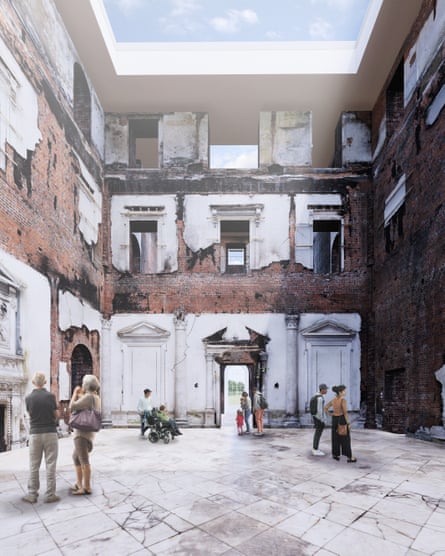Clandon Park, an elegant 18th-century stately home that was gutted in a fire in 2015, is to be mainly conserved as a ruin rather than restored to its former Palladian glory.
Plans by the National Trust, which has owned the Grade I-listed house since 1956, will allow visitors to see the “raw power and poetic beauty” of the building after the flames stripped away panelling and plasterwork and brought down floors, said Kent Rawlinson, the project director.
The external walls and windows of the building near Guildford, Surrey, will be restored by heritage craftspeople, but the interior will be largely conserved in its fire-damage state.
Once the work is complete, in about five years, a series of interior walkways and roof lights will allow visitors to view the shell of the house up close and from new angles.

“Despite the fire, Clandon remains a great house, but one physically laid bare, stripped back to its architectural skeleton, with its own visual power and significance,” said Rawlinson.
The interiors “reveal the otherwise hidden stories of many hundreds of people who together made the house and its furnishing: from brickmakers excavating local clay, to the pen of the Italian architect Giaciomo Leoni, and itinerant master craftsmen from Switzerland creating elaborate plasterwork ceilings”.
The estate was acquired in 1641 by the then local MP, Sir Richard Onslow. In the 1720s, members of the Onslow family remodelled the original Elizabethan house in the Palladian style. After it was handed to the National Trust it became a popular wedding venue.
The fire, which started in a faulty electrical board in the basement, swept through the four-storey house, causing its roof, ceilings and floors to collapse and destroying precious architectural features.
The baroque ceiling of the magnificent two-storey Marble Hall was destroyed, leaving the attic servants’ quarters visible and revealing a striking contrast between the 20ft-high ornate fireplaces of Clandon Park’s grand entrance with the modest, utilitarian fireplaces two floors above.
Fire damage has revealed metal holdfasts used to attach wooden batons to the brickwork, which were then built up with laths before a final layer of plaster or wood panelling. Elaborately hand-carved decorative plaster cornices were similarly built up layer by layer from brick walls.
“It isn’t quite an 18th-century building site, but it’s as close as you can get,” said Rawlinson. “It’s an X-ray vision of what lies behind the beautiful, detailed veneer.”
Only one room, the Speakers’ Parlour, survived the fire relatively unscathed, although its wooden panelling was removed to dry out after being drenched by firefighters, and its handcrafted baroque plaster ceiling will be repaired after chunks fell off.
Named for the three members of the Onslow family that became Speakers of the House of Commons, the former dining room will provide a counterpoint to neighbouring rooms ravaged by the inferno.
In the immediate aftermath of the fire, National Trust staff and volunteers saved about 600 precious objects out of 3,000 items in the Clandon collection. The rest were incinerated or badly damaged.

Salvaged items, including paintings, furniture, ceramics and textiles, will be displayed in the house. In some cases, artworks will be hung on bare brick walls.
Its new roof will be accessible to visitors, with spectacular views across Surrey as well as a bird’s eye view through roof lights into the shell of the house.
“We lost wonderful interiors and fascinating collections that we mourn. But the fire revealed a story about how a country house is made, from the skeleton outwards, which is remarkable and fascinating. Since the fire, we’ve understood how we can shape this into a unique experience,” said Rawlinson.
The National Trust declined to disclose how much the work would cost, but said it would be met by an insurance settlement plus funding from the trust’s reserves. The work is expected to be completed by the winter of 2027/28.
